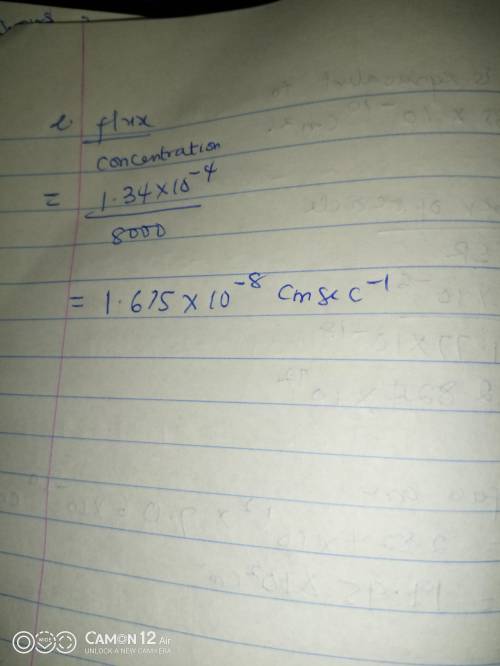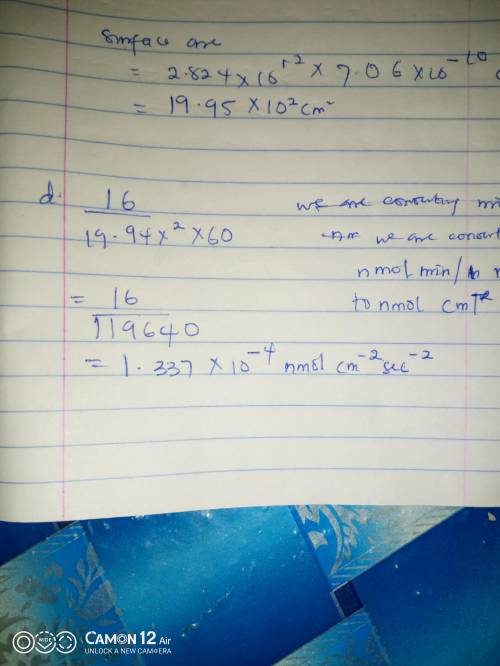
Biology, 13.10.2020 04:01 katlynnschmolke
When vesicles of the cardiac sarcoplasmic reticulum (CSR) are incubated with ATP Mg^2+ and Ca^2+, they take up Ca^2+ and reach a pseudo steady-state. This is a steady state that changes, but slowly. The uptake of Ca2+ is mediated by the SERCA2a Ca-ATPase. The uptake reaction can be quenched by adding EGTA to the external solution, which binds the Ca^2+ outside of the vesicles, or by adding glucose plus hexokinase, that converts the ATP to ADP and glucose-6 phosphate. When the uptake reaction is stopped, Ca^2+ that was already taken up by the vesicles leaks out passively A. The amount of Ca^2+ taken up by the vesicles is generally normalized to the amount of CSR protein in mg rather than being expressed as a concentration. A typical steady state Ca2 uptake is 40 nmol mg^-1. In separate experiments, the enclosed volume of the CSR vesicles was determined to be 5 mu L mg. What is the approximate concentration of Ca^2+ inside the vesicles at steady-state? The total Ca^2+ concentration is its amount divided by the volume in which it is distributed. In this case the amount is 40 nmal mg CSR protein^-1 and the volume is 5 mu L mg CSR protein^-1, The concentration is estimated as B. The average vesicle size determined by electron microscopy is about 150 nm. What is the volume and surface area of a vesicle this size, assuming it is a sphere? C. Given that the enclosed volume of the aggregate vesicles is 5 iL mg-1, how many vesicles are there per mg of CSR protein? How much surface area is there per mg of CSR protein? D. The initial passive efflux at a load of 40 nmol mg when the pump is stopped is 16 nmol min^-1mg^-1. Convert this to a flux in units of nmol cm^-2 s^-1 by dividing by the surface area per mg of CSR protein and converting min to s. E. What is the passive permeability to Ca^2+ in cm s^-1?

Answers: 3
Another question on Biology

Biology, 22.06.2019 04:00
Asolution of an enzyme and a substrate was placed in a water bath and the temperature of the reaction was raised gradually. the graph shown was plotted at the end of the experiment. what can be concluded from the graph? a) temperature has no effect on the activity of the enzyme. b) the effect of temperature on the enzyme is unpredictable. c) the enzyme shows increased activity up to a certain temperature. d) the activity of the enzyme is inversely proportional to the temperature.
Answers: 2

Biology, 22.06.2019 05:00
A60-tooth gear is connected to a 72-tooth gear.if the smaller gear turns 12 times,how many turns does the larger gear make?
Answers: 2

Biology, 22.06.2019 05:20
Categorize each term as something that is typical of a scientific theory, a scientific hypothesis, or both. makes predictions
Answers: 2

Biology, 22.06.2019 09:30
Laura yin suggested i contact you concerning the marketing position available at eastern arbor. i am inspired to pursue my marketing interests at eastern arbor due its reputation as a prestigious innovative and growing company in liability policies
Answers: 1
You know the right answer?
When vesicles of the cardiac sarcoplasmic reticulum (CSR) are incubated with ATP Mg^2+ and Ca^2+, th...
Questions


Computers and Technology, 30.08.2019 05:10


Computers and Technology, 30.08.2019 05:10








Mathematics, 30.08.2019 05:10

History, 30.08.2019 05:10

Mathematics, 30.08.2019 05:10

Mathematics, 30.08.2019 05:10



Mathematics, 30.08.2019 05:10

Mathematics, 30.08.2019 05:10






